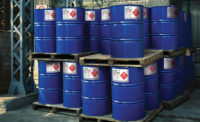Easy SDS binder updates to optimize your right-to-know station

In addition to following the specific OSHA-mandated requirements for safety data sheets (SDS), there are a few easy ways to upgrade your SDS binder to create a more thorough right-to-know station. This is important when considering OSHA hazard communication standard 29 CFR 1910.1200.
Also known as the right-to-know laws, 1910.1200 emphasizes that workers have a right to know about how to deal with work-place chemical hazards. Specifically, that chemical safety information should be “readily accessible during each workshift.”
Specific safety data sheet information is closely regulated by OSHA. However, exactly how you ensure those sheets are readily accessible to employees is not. Implementing these updates to your SDS binder helps you stay compliant and helps employees work more safely in two key ways.
1) Ensures workers can quickly and easily access up-to-date OSHA SDS chemical safety information
2) Upholds the spirit of the right-to-know laws, helping employees better understand chemical safety
Add a sheet to track SDS updates
The simplest update you can make to your SDS binder is a cover sheet for tracking when it was last audited and updated as a whole. No one wants to be surprised with missing or out-of-date SDS on inspection day.
HazCom violations have been in the top 3 of OSHA violations for the last decade, coming in at No. 2 in 2019. Auditing workplace chemicals 1-2 times per year is the perfect opportunity to identify missing SDS or out-of-date MSDS that should have been updated by the supplier and could lead to fine.
Sticking to a regular schedule for auditing and updating your SDS binder can help you identify and solve SDS problems before they become expensive citations.
Include OSHA supplements in your SDS binder
OSHA provides supplemental publications in both HTML and PDF format, such as a helpful HazCom FAQs. This type of information is not strictly required on chemical safety labels or safety data sheets, but it does help keep workers informed.
Printed OSHA PDFs are incredibly easy to tuck into SDS binder pockets for employees to use at will. Providing additional, easily accessible safety educational materials supports workers’ rights to be informed and creates an overall safer work environment.
Link to additional relevant safety info online
It’s easier than ever to provide additional information for employees using online OSHA HTML publications. Benefits of online safety information include saving on printing, the ability to address more varied topics and simultaneous access for workers.
But wait, what does that have to do with an SDS binder? Your SDS binder is the heart of your right-to-know station, which may include posters, pamphlets and other supplemental information. Using QR code labels, you can provide direct links to online supplemental information right from your SDS binder.
Using QR codes to supplement SDS binder info
QR codes are ideal for providing links to online information because they’re a type of two-dimensional barcode that can be scanned with any common smartphone. Workers can use their own phone to scan the QR code label on your SDS binder and instantly be linked to supplemental safety information online.
The types of information you could direct workers towards are virtually endless. You could link workers to online versions of every safety data sheet, your company HazCom policy, or directly to OSHA laws. Linking to OSHA publications online also ensures workers have access to the most up-to-date version.
How to create QR code labels for SDS binders
QR code labels sound fancy, but it’s not difficult to create your own. All you need is industrial design software for labels, durable blank labels and a couple tips.
1) Check your label supplier and/or manufacturer for low or no-cost software with a barcode generator tool. Adding a QR code with a barcode generator for labels is just a matter of choosing a barcode option.
2) Choose blank labels that match your SDS binder in durability. Standard paper office labels are easily damaged, making barcodes more difficult to read. Like SDS binders, durable industrial-grade labels made from polyester (PET) film are engineered to stand up rough use.
Help workers quickly access the right safety data sheet
OSHA SDS requirements are clear about SDS being readily accessible. Flipping through dozens of 16-part safety data sheets is not efficient without proper organization. Durable index tab dividers and a table of contents make it easier for workers to quickly navigate your SDS binder and find the exact information they need.
Quick SDS binder update checklist
- Add a cover sheet to track SDS binder updates
- Include printed OSHA supplements
- Provide additional online chemical safety resources
- Use QR codes for easy online access directly from your SDS binder
- Organize your SDS binder with index tabs and a table of contents
Looking for a reprint of this article?
From high-res PDFs to custom plaques, order your copy today!






.jpg?t=1721257160)

